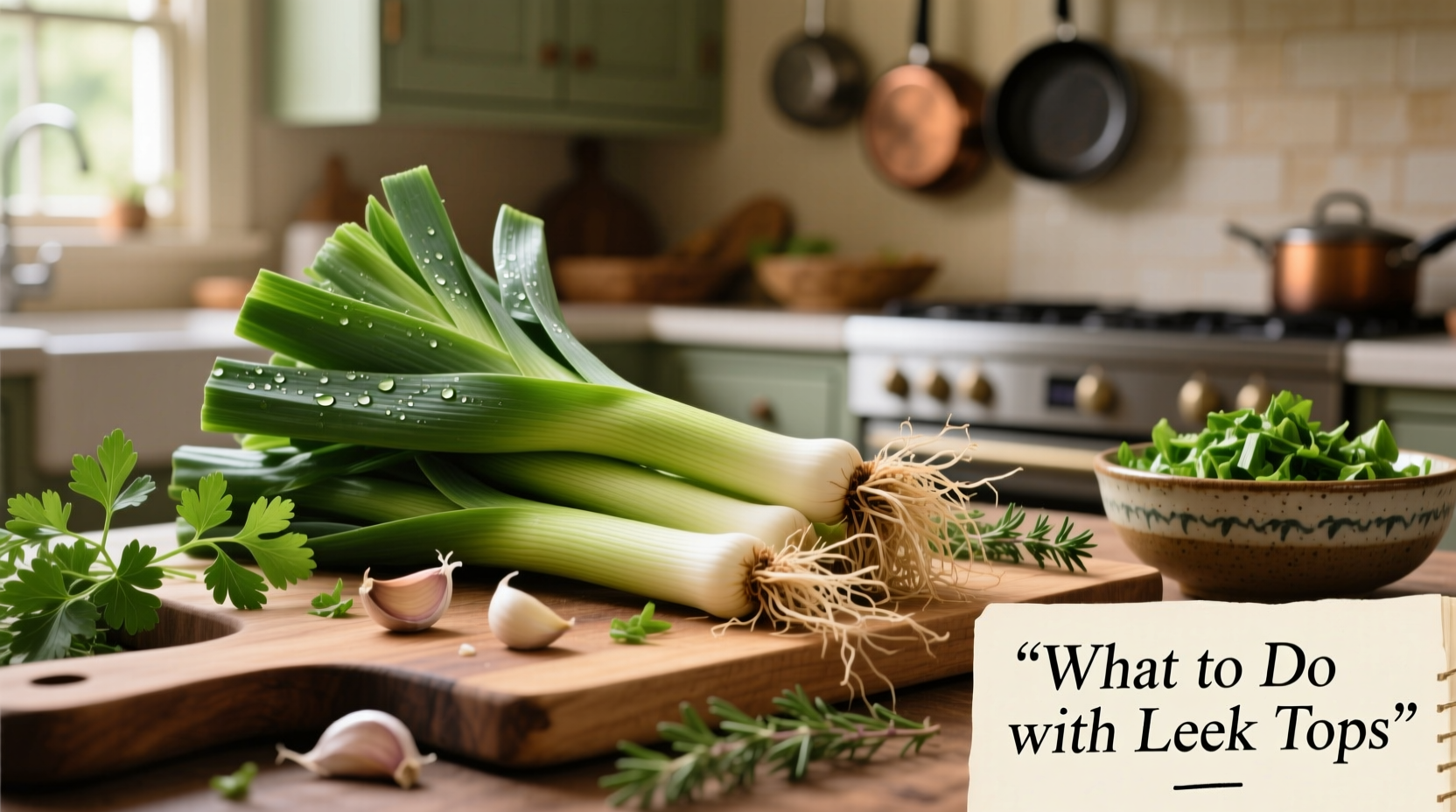Most home cooks toss the green tops of leeks without realizing they're throwing away a versatile ingredient packed with subtle flavor. According to USDA food waste statistics, nearly 30% of purchased vegetables end up in landfills, with edible portions like leek tops contributing significantly to this waste. By learning proper techniques to utilize these often-discarded parts, you'll not only reduce kitchen waste but also add nuanced flavors to your cooking repertoire.
Why Leek Tops Deserve Your Attention
Leek tops contain valuable nutrients including vitamin K, vitamin A, and dietary fiber. While tougher than the white base, their milder flavor profile compared to onions makes them ideal for subtle seasoning. Professional chefs consistently save leek tops for foundational cooking elements—this isn't just about sustainability but flavor development.
| Component | Nutritional Value (per 100g) | Best Culinary Uses |
|---|---|---|
| White base | Higher sulfur compounds, sweeter | Raw applications, quick sautéing |
| Light green section | Moderate fiber, balanced flavor | Stews, braises, roasted dishes |
| Dark green tops | Higher fiber, milder onion flavor | Stocks, pesto, finely chopped applications |
Essential Preparation Techniques
Proper preparation determines whether your leek tops enhance or detract from dishes. The key is understanding their fibrous nature:
- Cleaning thoroughly: Slice vertically, then soak in cold water to remove trapped soil between layers
- Textural management: Finely chop tougher tops or use specialized techniques for different applications
- Flavor extraction: Simmer longer than white portions to release maximum flavor without bitterness

5 Practical Applications for Leek Tops
1. Flavorful Vegetable Stock Foundation
Create restaurant-quality stock by simmering leek tops with other vegetable scraps. According to culinary research from the Culinary Institute of America, leek tops contribute a more delicate flavor than onion skins while providing similar depth. Combine with carrot peels, celery ends, and herb stems for a versatile base that freezes well.
2. Vibrant Leek Top Pesto
Transform your food processor into a waste-reduction tool with this simple technique: blend 2 cups chopped leek tops with 1/2 cup nuts (walnuts work well), 1 garlic clove, 1/4 cup Parmesan, and 1/3 cup olive oil. The University of Massachusetts Extension program confirms this approach preserves nutrients while creating a unique flavor profile distinct from traditional basil pesto.
3. Crispy Leek Top Fritters
Finely chop leek tops and incorporate into batter with chickpea flour, egg, and seasoning. Pan-fry for 2-3 minutes per side. These fritters work as appetizers or side dishes—their mild flavor appeals to children who might reject stronger onion varieties.
4. Infused Cooking Oils and Vinegars
Add cleaned leek tops to olive oil or vinegar in a sealed container. Let sit for 3-5 days at room temperature (refrigerate vinegar infusions). This technique, documented in agricultural extension resources from Cornell University, creates subtle flavor enhancements for dressings and marinades without overpowering other ingredients.
5. Garnish with Purpose
Thinly slice the tender upper portions for finishing dishes. Unlike harsh raw onions, properly prepared leek tops add visual appeal and mild flavor to soups, baked potatoes, and grain bowls without overwhelming other components.
When Not to Use Leek Tops
Understanding context boundaries prevents culinary disappointment. Avoid using leek tops directly in applications requiring:
- Raw salads when tops are overly fibrous (typically the darkest 1/3)
- Dishes requiring crisp texture (they'll remain softer than white portions)
- Recipes where visual presentation of uniform ingredients matters
When properly matched to appropriate applications, leek tops become valuable kitchen assets rather than waste products. The key is adjusting your technique based on their unique properties rather than treating them identically to the white portion.
Preservation Methods for Future Use
Extend your leek tops' usability with these professional techniques:
- Freezing for stocks: Chop and freeze in labeled portions for future stock-making
- Dehydrating: Create leek powder for seasoning by dehydrating at 125°F for 6-8 hours
- Quick-pickling: Use in vinegar brine for 24 hours for tangy additions to sandwiches
Frequently Asked Questions
Can you eat the green part of leeks raw?
The tender upper portions can be thinly sliced for raw applications like salads, but the darker, fibrous sections are best cooked. Raw leek tops have a milder flavor than raw onions but require proper preparation to avoid toughness.
How long do prepared leek tops last in the refrigerator?
Stored in an airtight container with a slightly damp paper towel, chopped leek tops remain fresh for 3-4 days. For longer storage, freeze them for stock preparation where texture matters less.
Why do my leek tops taste bitter?
Bitterness typically occurs when leek tops are overcooked or when using the very dark, outermost layers. Simmer rather than boil, and remove any discolored or damaged portions before cooking to prevent bitterness.
Can I substitute leek tops for scallions?
Yes, when properly prepared. Use the tender green portions of leek tops as a 1:1 substitute for scallion greens in cooked dishes. For raw applications, ensure you're using only the most tender upper sections and slice very thinly.
What's the best way to clean sandy leek tops?
Slice vertically first, then separate the layers and soak in a large bowl of cold water. Swish gently to release trapped soil, then lift the leeks out (leaving dirt at the bottom). Repeat if necessary. Never skip this step—leeks grow in sandy soil and trap particles between layers.











 浙公网安备
33010002000092号
浙公网安备
33010002000092号 浙B2-20120091-4
浙B2-20120091-4